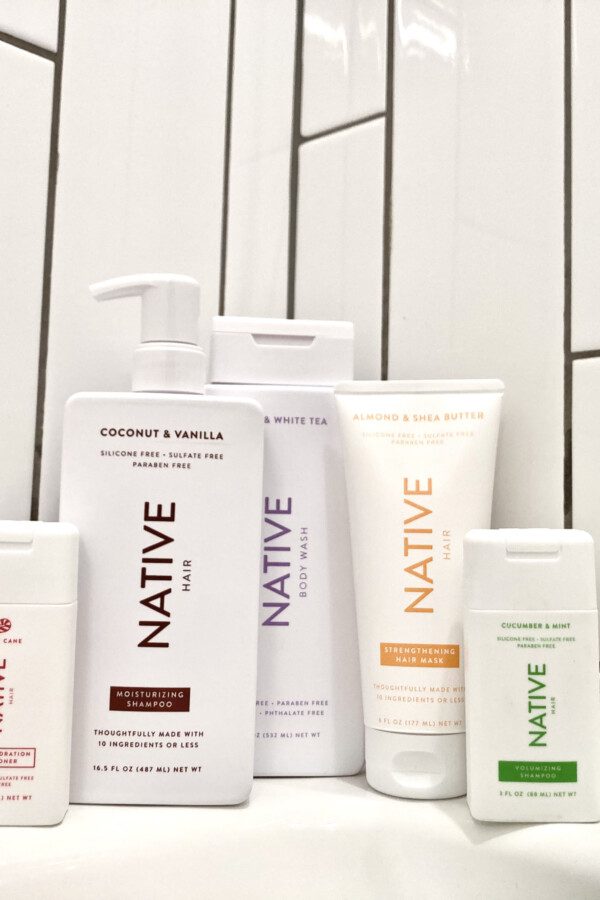You’ve probably heard that you should buy organic food whenever possible. But what does “organic” actually mean? What is the difference between organic and certified organic? And is it really healthier for you?
In this article, we’re going to answer those questions and more. Although different countries have different certifying bodies and requirements, this article will focus on the USDA, which is the governmental agency that certifies organic agriculture and meat products in the United States.
Table of Contents
- What Does The USDA Organic Label Really Mean?
- What Are The Requirements For a 100% Organic Label?
- The Different Types of USDA Certified Organic
- What Is The Difference Between Organic And Certified Organic? Can A Product Be Labeled Organic If It Is Not Certified?
- How Much Does the USDA Organic Certification Cost?
- What Kind Of Food Products Can Be Organic?
- Is Organic Food Really Healthier For You?
- Can Something Be Organic And Not Be Healthy?
- “The Big Three” Fighting Dirty To Be Included In Certified Organic Farming Practices
- Agencies That Affect, Certify, and Influence Organic Labels:
- Are Organic Fruits and Vegetables Worth the Expense?
- Top 5 Fruits & Vegetables Laden with Pesticides (and Worth Buying Organic):
- Top 5 Fruits & Vegetables Considered Most “Safe” If Not Organic:
- Beware of Greenwashing in “Organic” Foods
- Going Beyond Organic: What is Regenerative Farming?
- Conclusion
What Does The USDA Organic Label Really Mean?
When you see a product with a USDA organic label, it can mean a few different things depending on what type of product it is and whether the product is 100% organic or made with just some organic ingredients.
But essentially, the USDA organic label indicates that a product (or an ingredient used in a product) was grown, raised, processed, and treated without the use of most synthetic pesticides, fertilizers, hormones, sewage sludge, irradiation, genetic engineering, and other additives.
In order to earn a USDA label, farmers and food processors have to meet specific criteria and then pass an audit conducted by a third party certifying agent, who ensures accountability. We’ll look at those specific criteria in a minute.
There are several different labels and certifications that indicate something was made organically, and the USDA is just one of them (though it’s the most widely used and well-known in the States). We’ll talk about some other labels below.
This post may contain affiliate links, which means we may earn a small commission if you choose to make a purchase. We only make recommendations that are genuine and meet our ingredient/material safety standards.
What Or Who Is The USDA?
USDA stands for United States Department of Agriculture. It’s the governmental body that not only oversees organic food certification in the U.S., but also develops other laws related to agriculture, farming, and food.
The United Sates Supplemental Nutrition Assistance Program (or SNAP, formerly known as food stamps) is run by the USDA. The United States Forest Service (USFS), which manages about 25% of national forests and grasslands, is also under the USDA. (Although, the USFS is separate from the National Park Service, or NPS. The two divisions both manage national land, but have different goals when it comes to the purpose of the land they manage.)
USDA vs. FDA
Some may confuse the USDA with the Food and Drug Administration (FDA). Although they are both governmental agencies that oversee the safety of food and other products, they do have different roles.
While the USDA oversees agriculture, meat, poultry, and eggs, the FDA regulates pretty much everything else we eat and drink (including packaged foods, alcohol, etc.) as well as pharmaceuticals and dietary supplements.
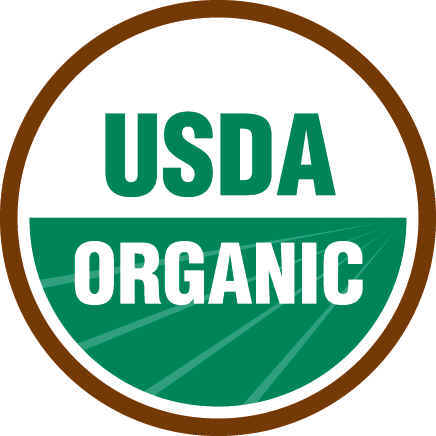

The two labels above are the only two official USDA organic seals. Using a look-alike organic label and on food products can result in fines.
What Are The Requirements For a 100% Organic Label?
In order for a product to be 100% organic, it must be grown, raised, and processed without the use of:
- most synthetic pesticides
- most synthetic fertilizers
- growth hormones
- sewage sludge
- irradiation
- genetic engineering (genetically modified organisms or GMOs)
But, a farmer can’t just stop using these substances one day and apply for an organic certification the next. It takes a long time for the residues of these chemicals to be filtered out of the soil. For this reason, a farm must be free from the above substances for three years before it can qualify for organic certification. Although farmers cannot sell, label, or represent their goods as organic or use the USDA organic seal during these three years (even though they are technically using organic practices), the USDA does offer technical and financial assistance to farmers during this transition period.
There are some exceptions to the list above, too. For crops, for example, farmers are allowed to use newspaper (which is considered a synthetic) for compost. For livestock, synthetic exceptions include vaccines and electrolytes. There are also some natural substances that are NOT allowed, like arsenic and strychnine.
Farms that want to receive a USDA organic certification must go through an inspection with a USDA-accredited certifying agent. For crops, these agents inspect fields, soil conditions, approaches used to manage weeds and pets, water systems used, storage, and equipment. They might take soil samples and perform residue tests as well. For livestock, the agents inspect things like feed production, animal living conditions, preventative health management practices, and animal health records. They may take tissue samples to test, too.
Certified farms and food processors have to go through this inspection and certifying process once a year in order to continue to use the USDA organic labels on their products.
The Different Types of USDA Certified Organic
There are essentially three different types of organic labels given out by the USDA:
- “100% USDA Organic” means exactly what it sounds like: the product contains 100% organic ingredients.
- “USDA Organic” means that at least 95% of the ingredients in the products are organic. The remaining 5% of the ingredients that are NOT organic have to be on the “National List of Allowed and Prohibited Substances.” For example, a product can contain non-organic baking soda or citric acid and still carry the “USDA Organic” label (as long as those ingredients do not add up to more than 5% of the product).
- “Made with Organic __________” means that a product is made with certain ingredients that are certified organic. For example, chocolate chip cookies might be “Made with Organic Chocolate”, but the wheat used to make the flour is not organic. In order for a product to have this label, it must contain at least 70% organic ingredients.
Products that contain less than 70% organic ingredients cannot bear the USDA Organic label. If they use some organic ingredients, they can indicate that on the ingredients list. As an example, let’s look at these two bags of tortilla chips:


The first bag (Chia Quinoa) carries the USDA organic label. The ingredients listed are: Organic Whole Ground Corn, Organic Sunflower and/or Organic Safflower Oil, Organic Quinoa, Organic Chia Seed, Sea Salt, Calcium Hydroxide.
As you can see, at least 95% of the ingredients are organic.
The second bag (Jalapeño Lime) does NOT have the USDA organic label even though the first ingredient is organic: Organic whole ground yellow corn, expeller pressed non-GMO sunflower oil and/or expeller pressed non-GMO safflower oil, non-GMO jalapeno lime seasoning (maltodextrin, dextrose, sea salt, jalapeno pepper, green bell pepper powder, onion powder, garlic powder, vinegar powder [maltodextrin, white distilled vinegar], yeast extract, spices, lime juice powder [maltodextrin, lime juice], citric acid)
The Jalapeno Lime chips contain less than 70% organic ingredients. It CANNOT have the USDA organic label, but it CAN list the relevant ingredients as organic on its label.
What Is The Difference Between Organic And Certified Organic? Can A Product Be Labeled Organic If It Is Not Certified?
In the United States, it is illegal for a company to label or market a product as “organic” without it actually being certified organic by the USDA. Farmers and food manufacturers have to be very careful about this because violations can result in hefty fines (up to $18,530 per violation).


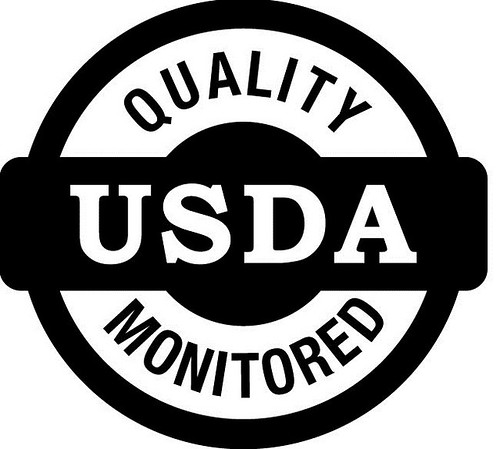

Here are some examples of fake USDA organic labels. See the difference between these and the official labels above?
On one hand, this law is a good thing because it helps prevents greenwashing. Companies cannot legally advertise a product as organic if it has not been verified to be so by a third party under a strict set of standards.
On the other hand, this law can hurt smaller farmers who do use organic farming practices but have not been certified organic by the USDA. Becoming certified can be expensive and many small farms cannot afford the extra costs (or they choose to save that money and pass along the savings to their customers by selling their goods at a lower price).
For this reason, farmers who do use organic practices but are not certified have to be careful in how they phrase things to customers. Instead of saying “Our produce is organic,” they might say something like “We grow produce without using synthetic pesticides or fertilizers or GMO seeds.”
How Much Does the USDA Organic Certification Cost?
According to the USDA, the fees involved in getting an organic certification “range from a few hundred to several thousand dollars” and can depend on the things like the size, type, and complexity of the operation.
Realistically, however, it’s going to cost somewhere around $700 to $1,200 for the certification. And that doesn’t usually include the application fee, annual renewal fees, and inspection and assessment costs. This can be a lot for small farms (although, there are cost-share programs available that could potentially help offset those costs).
What Kind Of Food Products Can Be Organic?
The USDA organic certification covers most agricultural products and many byproducts, such as:
- Crops (like wheat, soy, nuts, fruits, and vegetables)
- Products made from those crops (i.e. almond milk made from certified organic almonds)
- Livestock (like beef and chicken)
- Foods with organic ingredients (as discussed above)
- Textiles (like cotton)
Body
The Best Foods to Stimulate The Vagus Nerve (…or Not)
With knowledge of the vagus nerve and just how important this cranial nerve is in physical and mental health, people are naturally on the search for ways to support it. The usual curiosity is, are there foods that stimulate vagus nerve functions?
Is Organic Food Really Healthier For You?
As we discussed here, the answer is: yes. Organic food really is healthier for you.
Conventional (or non-organic) crops are sprayed with pesticides and other toxic chemicals that have been linked to everything from cancer and ADHD to infertility and Parkinson’s and more.
This makes sense when we consider the fact that many of the herbicides that are used today were originally developed to be poisons like Agent Orange.
Organic food also tends to have more nutrients. Considering that many people are nutrient deficient, organic food can help to solve that problem. It is often more flavorful as well!
Not only that, but there are many reasons that organic crops are better for our communities and society in the long run. Whereas conventional monocrop farming strips topsoil, organic and regenerative farming maintains the healthy soil that future generations will need for their food supply. Organic farming also helps to protect our pollinators (which necessary for food production and healthy ecosystems, but are endangered).
Additionally, millions of dollars in subsidies are given to conventional farmers each year in order to keep them running. Therefore, organic agriculture can save taxpayers’ money as well.
Those that are in more sensitive populations (pregnant women and babies, people with chronic illness, etc.) will find it even more important to eat organically since they are at a higher risk for the negative consequences of pesticides.
Can Something Be Organic And Not Be Healthy?
Generally, foods that are certified organic are likely going to be healthIER than foods that are non-organic and/or processed foods that are filled with additives.
But just because something is organic or contains organic ingredients doesn’t automatically mean it’s “healthy.” Technically, what is “healthy” can vary from person to person anyway. A product can be organic and still be filled with sugar, which in too high of quantities can lead to things like diabetes, IBS, and general inflammation. A product can be organic and still contain things like wheat, dairy, and oils that can cause problems for some people.
RELATED: Best (Online!) Organic & Natural Food Stores
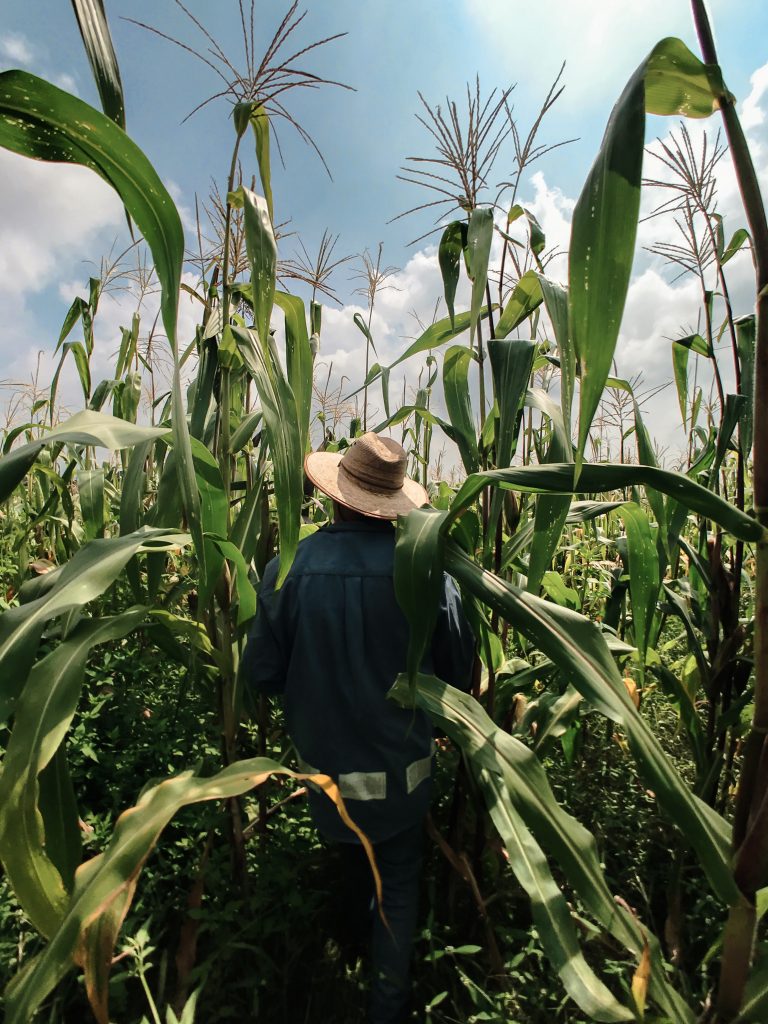
“The Big Three” Fighting Dirty To Be Included In Certified Organic Farming Practices
It’s also important to realize that just because something is certified organic doesn’t mean it’s perfect. For example, there have been certified organic confinement livestock facilities (which is basically the opposite of free-range, where livestock are unethically smashed together and often left without access to the outdoors). Hydroponically grown produce (a controversial method where produce is grown without the use of soil) can also be certified organic, which some people believe should not be allowed.
But there are three big things that many lobbyists in Washington are trying to change, which would further weaken the USDA organic standards:
1. GMOs
At the time of publication, GMOs and genetic engineering (GE) are prohibited from being used in any USDA-certified products. However, in 2019, the Trump administration was toying with the idea of allowing GMOs and genetic engineering in certified organic products.
2. Sewage Sludge
Yes, it’s exactly what it sounds like: sewage sludge (also called “biosolids”) is a mix of anything and everything you flush down your toilet and sinks. It might surprise you to learn that roughly 50% of the biosolids created in the U.S. are applied to land, with the majority being used in agriculture.
This isn’t necessarily a bag thing—humans have been returning their excrements to the soil for a VERY long time, completing a nutrient loop and keeping these biosolids out of landfills. Technically, human urine and feces COULD be an effective fertilizer the same way manure is. But these days, there is just way too much contamination. In addition to everything else that gets flushed down our drains (toilet paper, etc.), these “biosolids” can contain anything and everything, from bacteria and viruses to pharmaceuticals, heavy metals, and hormone-disrupting chemicals like PFOAs. Many of these contaminants are not regulated by the FDA and can be harmful to crops.
Certified organic products cannot be grown using these biosolids, but the USDA has attempted to allow the use of these biosolids in organic products before.
3. Irradiation
Irradiation is a process that’s similar to pasteurization in that it is used to eliminate harmful organisms like E. coli from foods. The process involves applying a small amount of radiation to the food. Of course, getting rid of bad bacteria is a good thing, but this process can also get rid of beneficial bacteria, vitamins, and minerals as well, making irradiated food less nutritious.
This is another thing that is still not allowed in certified organic products, even though there have been several attempts made by lobbyist groups to get rid of this rule.
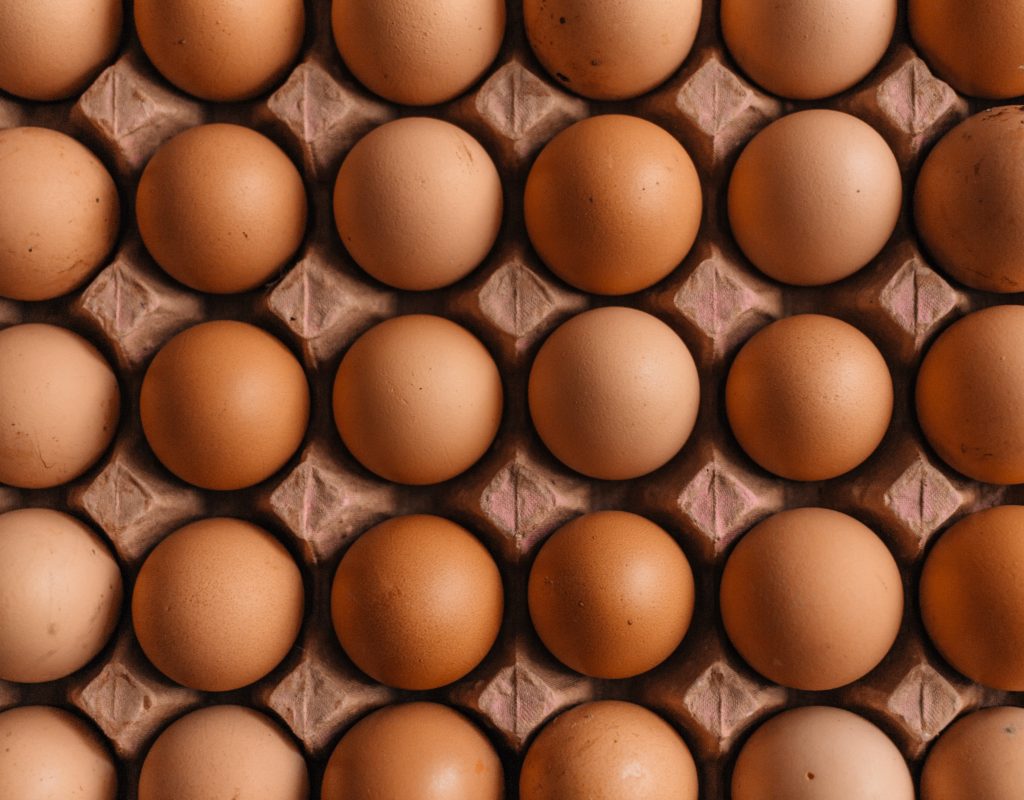
Agencies That Affect, Certify, and Influence Organic Labels:
In addition to the USDA, you may see some other labels or organizations that represent organic interests. These three governmental agencies work with the USDA:
- National Organics Program (NOP): This is the body that accredits third-party certifying agents who then inspect and assess certified organic farms and businesses.
- National Organic Standards Board (NOSB): This is the Federal Advisory Board, which is made up of 15 people, that actually decide on what the USDA certification standards are.
- Food Safety and Inspection Service (FSIS): This is the organization that inspects meat, poultry and egg products (both organic and non-organic) for safety. The labels you see on your beef like “USDA Prime,” “USDA Choice,” and “USDA Select,” are set by the FSIS.
The rest of these organizations are not associated with the USDA:
- Regenerative Organic Certified (ROC): “ROC™ farms and products meet the highest standards in the world for soil health, animal welfare, and farmworker fairness.” More on this below.
- Non-GMO Project Verified: “North America’s most trusted third-party verification for non-GMO food and products.” (Non-GMO products may be non-organic though. Non-GMO refers to the seeds used, not the growing practices.)
- Organic Farmers Association (OFA): Started “to put farmers in the driver seat to advocate and educate for more domestic organic farms, strong organic standards, and technical assistance and education to support a national growth of organic farming.” This is not a certification, but rather a membership association for organic farmers (and their supporters).
- National Organic Coalition (NOC): “a national alliance of organizations working to provide a ‘Washington voice’ for farmers, ranchers, environmentalists, consumers and industry members involved in organic agriculture.” This is not a certification, but rather an organization that represents the larger organic community in Washington.
Body
Is Microwave Popcorn Healthy or Bad for You?
It turns out, most microwave popcorn comes with chemicals that are known to cause long-term health problems in humans. Learn about what those chemicals are, and which are the healthiest popcorn brands.
Are Organic Fruits and Vegetables Worth the Expense?
As we’ve written before, organic foods aren’t always more expensive… but they often are (at least, in the short term). When you consider the potential long-term effects of things like pesticide residue consumption and nutrient deficiency, however, you might start to think about it differently. An extra few dollars on your grocery bill could end up saving you in healthcare costs down the road.
There are, however, ways to save money when shopping organically. One is to buy from online organic food stores, many of which are able to provide discounted products by cutting out the middlemen.
Another way to cut costs is by prioritizing which products you buy organic (and which ones you buy conventional to save money.) There is a really easy tool to help you decide: the Environmental Working Group’s (EWG) “Dirty Dozen” and “Clean Fifteen.”
Each year, the EWG tests a wide variety of fruits and vegetables to find out which ones contain the most pesticides. The produce on the Dirty Dozen list should be purchased organically if possible, where the fruits and veggies on the Clean Fifteen list are safer to buy non-organic.
Top 5 Fruits & Vegetables Laden with Pesticides (and Worth Buying Organic):
- Strawberries
- Spinach
- Kale/Greens
- Nectarines
- Apples
Top 5 Fruits & Vegetables Considered Most “Safe” If Not Organic:
- Avocado
- Sweet Corn
- Pineapple
- Onions
- Papaya
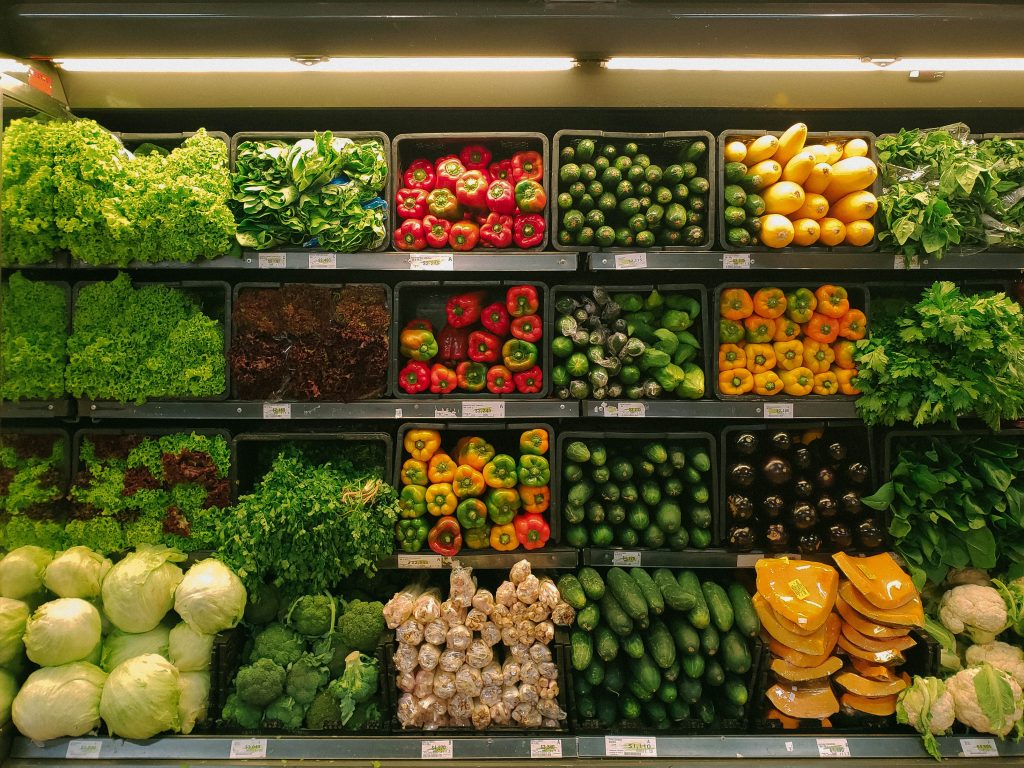
Beware of Greenwashing in “Organic” Foods
Even though it’s illegal to label or call a product “organic” without a USDA certification, that doesn’t mean companies won’t find some sneaky loopholes to try and subconsciously communicate to consumers that their products contain the same benefits as organically grown and produced ones do. Here are some words and labels to look out for:
“Natural.” There are no standards are certifying bodies that regulate “natural” products. Not only that, but just because something is “natural” doesn’t mean it’s healthy (for example, arsenic is natural).
“Humane” and “Pasture-Raised.” There are no standards or oversight for either of these claims either.
“No added hormones” or “Raised without hormones”. Federal regulations have never permitted hormones in poultry and pork, so this label doesn’t really mean much.
“Free Range” and “Cage Free.” The USDA does provide voluntary certifications for these. They are usually better than nothing, but they can have their shortcomings. For example, free range animals are not necessarily pasture raised (meaning they were provided with feed, which could be non-organic). And even though cage free chickens *technically* don’t live in a cage, that doesn’t mean they aren’t still totally overcrowded.
When possible, it’s best to buy your produce, meat, and animal products locally so that you can actually know the farmers and see for yourself whether the claims they make are legitimate!
“Organic” Non-Food Items
It’s also worth noting that the USDA certified organic label only applies to agricultural goods. Products like body lotion, laundry detergent, clothing, and bedding may come with other kinds of certifications (like GOTS organic cotton, for example), but that is completely different from USDA organic. These types of products are rife with greenwashing, so it’s important to know what to look for and shop from trusted and transparent brands.
Going Beyond Organic: What is Regenerative Farming?
Despite its controversies and shortcomings, USDA organic food is definitely better than conventional, non-organic food. When something is grown organically, it means the soil is not being poisoned and stripped of its nutrients by synthetic pesticides and fertilizers. But, what if there was a way of farming that wasn’t just NOT BAD, but was actually BENEFICIAL for the soil (and therefore our food supply, and our health)? Enter: regenerative farming.
Regenerative farming is not new; the process of growing and raising food in a way that actually benefits and heals the entire ecosystem involved has been used for centuries. But, there is a renewed interest and motivation to take organic goods one step further, with the help of non-profit organizations like Regenerative Organic Alliance (ROA). As their website states:
“We exist to heal a broken system, repair a damaged planet, and empower farmers and eaters to create a better future through regenerative organic farming. By adopting regenerative organic practices on more farms around the world, we can create long-term solutions to the climate crisis, factory farming, and fractured rural economies.”
Conclusion
Unfortunately, there is a lot of confusion in the world of “organic” products and therefore the burden is on the consumer to get educated and informed. Even though there is progress to be made in terms of organic standards and consumer clarity, buying organic whenever you can is definitely a better option than not!
PIN IT:











